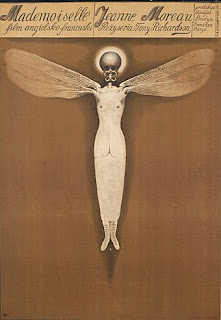Jan Lenica (1928 - 2001)
Studied at
the Poznań College of Music.
Studied at
the Architecture Department of Warsaw Polytechnic.
Jan Lenica
became neither a musician nor an architect. His father, Alfred Lenica, pushed
piano lessons on him. Interestingly,
later in life Alfred Lenica became a well-known abstract painter (More on
Alfred Lenica later.) As fate would have
it, Jan Lenica emerged as a talented painter and became an illustrator,
stage designer, graphic designer, poster artist, and animator. Allegedly he
coined the phrase "Polish School of Poster."
From 1963 -
1986 he lived and worked in France.
From 1987 -
2001 he lived and worked in Berlin.
Posters: Jan Lenica started off as a cartoonist for Pins.
His style, often satirical and simplistic, transitioned well into Poster
art where he developed a distinctive, almost painterly aesthetic, highlighting
abstract use of color and line.
Animation
and Films: Lenica's first films were
cut-out stop animations. In both theme and style, his animations built upon his
preexisting work in cartoon and poster. In 1957, Lenica produced his first animation
Był sobie raz (Once Upon A Time) along with Walerian Borowczyk (More on
Borowczyk later). The pair
would henceforth work on many short animated films often experimental in
nature, somewhat adult in theme and absurdity, but almost childlike in spirit
and imagination. These films would go on to inspire the likes of Roman Polanski,
the Brothers Quay, and Terry Gilliam, amongst others. In 1979, he was the first professor of the
animation class at the University of Kassel, Germany. He also taught at Harvard
University, Cambridge MA, 1974 and Academy of Fine Arts in Berlin, 1986-1994.
The first thing I did in Kraków during my last
visit was to proceed from the train station directly to Stolarska 8-10, the address
of Krzysztof Dydo's (more on Krzysztof Dydo later) Galeria Plakatu, Krakow (http://www.cracowpostergallery.com/) to
purchase the book Jan Lenica: Labirynt
by Ewa Czerwiakowska and Tomasz Kujawski. On a previous to visit to Galeria Plakatu I purchased my first
Polish poster: Lenica's Schach Und Kunst (Chess and Art.)




























































